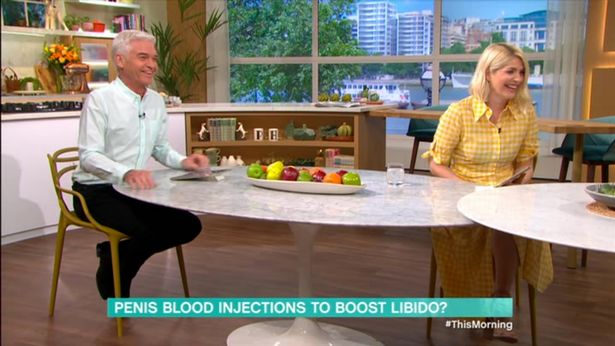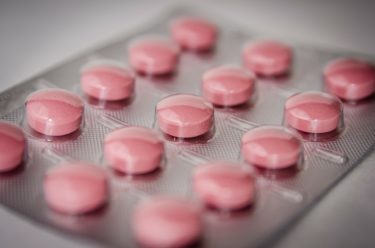Last month, an article in the Mirror about This Morning led me to a story in The Metro from back in June 2020 about sex and the pandemic, headlined “Doctor says she’s seen a surge in men asking for penis injections to last longer in bed in lockdown”. The article began:
Could time in lockdown be upping the pressure for men to last longer in bed and have rock-hard erections at a moment’s notice? A leading intimate health specialist and doctor, Dr Shirin Lakhani, says she’s seen a dramatic rise in enquiries for her P-shot procedure – a treatment that sees blood injected into the penis – since lockdown came into place.
The P-shot is either something I’ve come across before, or it’s something so completely predictable that I’ve just assumed it exists. The article goes on to say:
She reckons this may be down to all the stress of the pandemic – from lost income to health-related anxieties – causing erectile issues and other struggles in bed, along with dips in sex drives. But she also believes that all the time cooped up at home might allow previously hidden sexual issues to become apparent to the person’s partner…
‘A lot of the men I’m hearing from have struggled with sexual intercourse for years but have until now managed to hide the fact that they are unable to get an erection or can’t ejaculate,’ says Dr Lakhani. ‘Before lockdown they managed to hide their problem behind the fact that they were tired from work or because they were physically away a lot due to work.
This, to me, is a sad indictment of how we handle sex related topics in our society; that there are men prepared to adjust their entire lives – the implication here that they avoid sex entirely – or pay £1,200 to have blood injected into their penis, rather than talk to their partners honestly about difficulties they’re having either with getting an erection or with ejaculating.
If there’s one thing that the women’s wellness industry does help with, it’s getting people talking about personal issues. Over the years it’s become well established that women can find it difficult to orgasm, and that that is ok. But for men, and particularly men who have penises, it is such a taboo topic that it’s still considered a joke.
Which, brings me back to The Mirror article, which referred to a segment on This Morning, with Phillip Schofield and Holly Willoughby, who were talking to Doctor Sara Kayat about how the P-shot might enhance erections and boost the libido. Predictably, the presenters descended into their characteristic fit of giggles, and the segment ended pretty promptly.

So this is the time to mention – difficulty getting erections and ejaculating are completely normal. Just like for people with vaginas who struggle to climax, it can be related to a whole range of things including stress, medication, alcohol, depression, anxiety and tiredness.
It can, however, be a sign of a health concern – so like for most things, if you notice a change in what is normal for you, it’s worth getting checked out. But for some people, it’s just a little more challenging to get an erection and/or climax. What doesn’t help is making it such a taboo topic that people feel the need to avoid sex entirely just to avoid discussing the issue. That pressure is almost certainly going to make getting an erection and/or orgasming even harder.
The P-Shot
But what about the P-Shot? Is it the answer for some people?
The P-shot varies from clinic to clinic but broadly, most of them take blood from the patient, spin out the platelet rich plasma (PRP) using a centrifuge and then inject that into the penis.
And while I can find a lot of clinics offering this treatment, what I can’t find is many concluded clinical trials suggesting that this treatment actually works. I have found a few that are in process – clinical trials of small cohorts of patients, sometimes specifically with erectile dysfunction related to issues with the small blood vessels that bring the blood needed to sustain an erection. In most cases, these trials are open label and aren’t placebo controlled. I don’t see any that have released data specifically on PRP injection into the penis. I did find one study which had reported some data – but it gave very limited information on how the study was conducted, and included a note regarding one patient:
In the first follow-up of a patient after the 3rd injection, a 4-mm diameter fibrotic plaque was observed on the ventral side in the middle of the penis shaft.
Which is a little concerning.
I’m also not entirely sure what the scientific principle behind the P-Shot would be – there are a lot of vague theories about “rejuvenating tissue”, but for many people, the difficulties in getting or sustaining an erection are related to stress and tiredness, not something that’s physically wrong with the penis. Even if it is due to a health condition, it’s often clogged arteries due to high cholesterol rather than specifically damaged tissues. Clogged arteries or conditions like diabetes can lead to damage to tissues or blood vessels, but even then, treating the root cause has to be the priority before considering how to treat damage to those tissues. I strongly dislike the idea of a person going to a private clinic for an injection which might not include a consideration of health conditions that might be a contributing factor for that patient.

If, for example, the person is struggling to get an erection or ejaculate due to the side effects of a medication, it might help to switch that medication for a different one that does the same thing. For me, talking to a doctor about side effects should always be a priority – we so often have many different medications that we can try that it’s easy to switch out for a different one and see if the side effects are more tolerable.
If that isn’t an option, sometimes there are other medications that can help that are much cheaper and better researched than injecting some platelets into your penis (which, since we haven’t studied it that much, we don’t really know what the long-term effects are). If it’s caused by high cholesterol and you caught it early, it may just be a simple case of taking some statins to lower your cholesterol. And of course, there is always Viagra and the related compounds which help for many people.
As part of my research, I read an article for Men’s Health written by someone who tried out the P-Shot from a company called GAINSwave, which is apparently owned by a guy called Dr Dick Gaines (I’m guessing that’s not his real name). The story involves numbing cream, a “nerve block” shot (which I’m assuming is just local anaesthetic), a sound wave machine which the guy describes as “jack hammering” his penis, and, finally, a pump.
He described the result of his treatment this way:
Four hours later, back at my hotel room, I awkwardly fumbled with the pump, trying to remember how they’d put me inside it at the clinic. I oriented my penis just right and flipped on the button. Schloop. I sat for ten minutes as it whirred, hummed, buzzed and sucked me up to a shockingly high, self-satisfactory ten-inch mark.
For context, the average length of an erect penis when not described in bravado-laden terms for men’s health magazines that contribute to a society of unrealistic expectations is five to seven inches.
Then, a few minutes after I removed the pump and about exactly when the last drops of numbing cream wore off, it happened. My penis became big. Throbbing. A porn-star-esque mass of quivering, hard tissue.
Now, I’m no medical doctor, but I’m going to assume his large erection has more to do with the machine sucking blood in the direction of his penis, than it does the injections. In fact the NHS website says:
Vacuum pumps encourage blood to flow to the penis, causing an erection. They work for most men and can be used if medicine is not suitable or does not work. They’re not always available on the NHS. Speak to a doctor about where to get a vacuum pump.
Any anecdotal benefit from these sorts of treatments could be a form of placebo effect of sorts – we know that in a lot of cases difficulty with erection or climax come from the brain and not a physical effect. You struggle to get an erection one time; you worry your sexual partner will be offended and society tells you that people with penises find it really easy to be horny all the time and it’s super embarrassing if you struggle. So it becomes a big deal, and the next time you go to have sex you get worried about it, maybe you get so worried that you can’t even focus on the sexy time you’re having and you struggle again. Suddenly you’re making excuses not to have fun with a partner because you’re worried it’ll lead to sex that has an expectation of an erect penis (which is not all sex but that’s a rant for another day) and you’re on a path of stress and anxiety that makes it near impossible to get an erection.
Maybe, in those cases, seeing someone who tells you they have the cure helps your brain get past that anxiety block and you see an improvement. But just as easily you put so much pressure on that being the answer that it has no effect and you feel even worse.
There are some studies looking at injection into the penis in order to help treat erectile dysfunction. They’re certainly not enough to prove it works, nowhere near, but they do exist… but they don’t inject platelet rich plasma, they using stem cells. A review looking at all these studies concluded:
Our analysis revealed that SC therapy represents a promising option to treat ED, although published data exist for less than 100 patients. Large placebo-controlled trials with longer follow-up are needed to confirm the long-term safety and efficacy of SC therapy for ED.
Mostly the stem cells used for these studies are derived from the placenta, umbilical cord or bone marrow. This is not a simple ‘take your own blood, spin it out, and then inject it back in’ sort of treatment. From a scientific perspective the theory must be related specifically to erectile dysfunction which has a physical cause related to the penis and not medication, tiredness, alcohol, stress, depression or anxiety.
The study also looked at patients with a condition called Peyronie’s disease: curvature of the penis when erect, which might be caused by scar tissue from injury while erect. Peyronie’s disease is usually associated with the formation of a plaque on the side of the penis – which reminds me of the study I mentioned earlier, which found one patient developed a plaque in the penis after three injections. Peyronie’s disease is largely fine for most people, but it can be associated with pain and require surgery to help alleviate this in severe cases.
Ultimately, I think it’s always useful to talk about these topics widely, and it’s great that there are studies into novel treatments for erectile difficulties. It’s important to distinguish between what is a true erectile difficulty and what might just be a few weeks of struggle when you’re particularly stressed – like in a global pandemic – but either way, if you’re worried, get it checked out by an actual doctor. But I don’t think the answer is to spend a lot of money getting your penis injected with your own platelets. We don’t really know much about the long-term safety of these shots, nor do we know if they even work.



